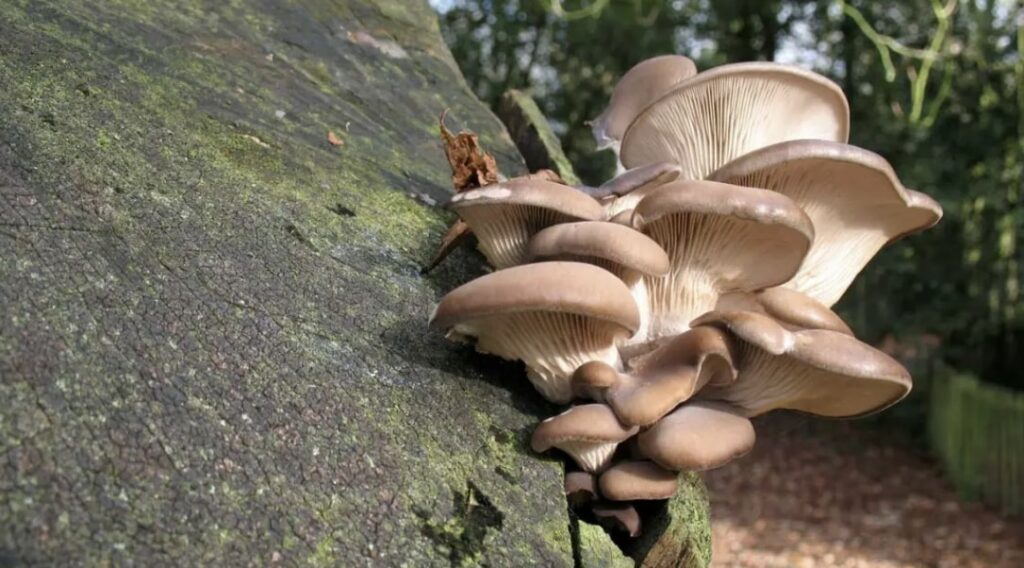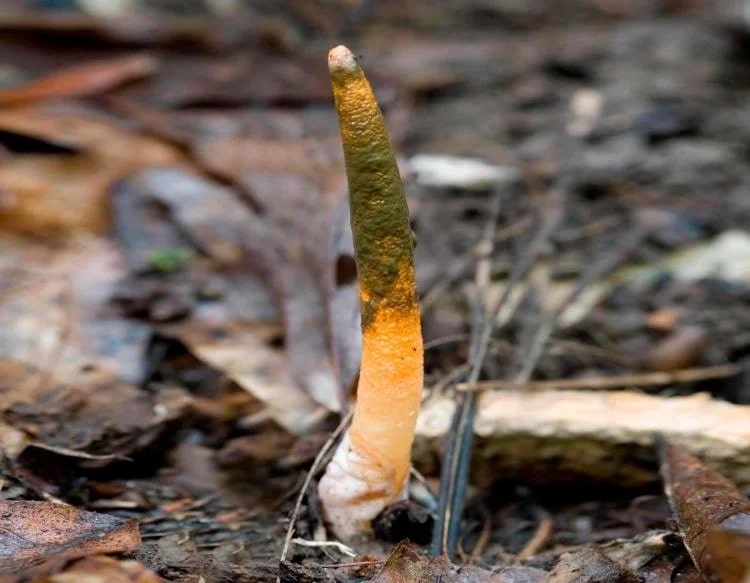
If there was a list of ugly-looking mushrooms, stinkhorn mushrooms would most likely be on top of that list.
Stinkhorn mushrooms are known for their strange appearance and unpleasant odor. They are also saprophytic, which means they feed on dead organic matter.
Let’s get to know the most common stinkhorn mushroom species you might encounter and how to get rid of them.
What do stinkhorn mushrooms look like?
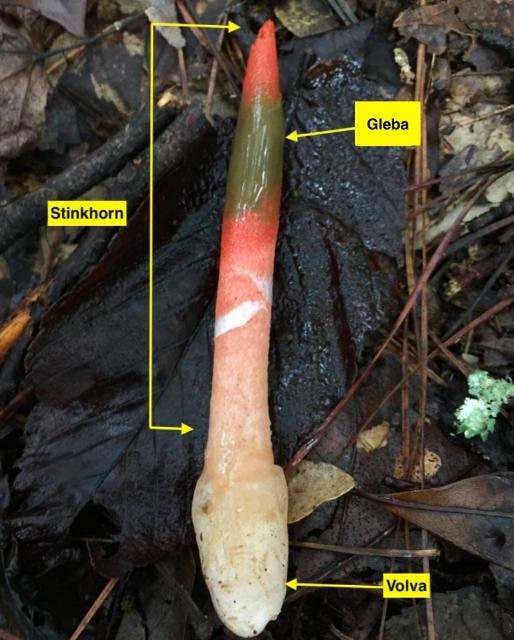
Stinkhorn species, which come from the family Phallaceae, usually look like horns, phalluses, or octopus appendages. Others have a lace-like veil below the cap, covering the mushroom stalk.
Their colors vary from white, olive, orange, red, or black.
The stinkhorn mushroom begins with white, pink, or purple-hued egg-shaped masses called volva.
Afterward, the wet and humid conditions permit the hollow stalk and cap of the mushroom fungus to grow out of this bulbous base.
The mushroom cap of a stinkhorn mushroom is covered by a slimy pore-containing substance called gleba.
Its odor has been likened to the smell of rotting carrion or dung.
These stinkhorns develop as fast as 4 to 6 inches per hour. The good news is some of them last only for 12 hours.
Here are the most common stinkhorn species and their distinct characteristics.
1. Common stinkhorn (Phallus impudicus)
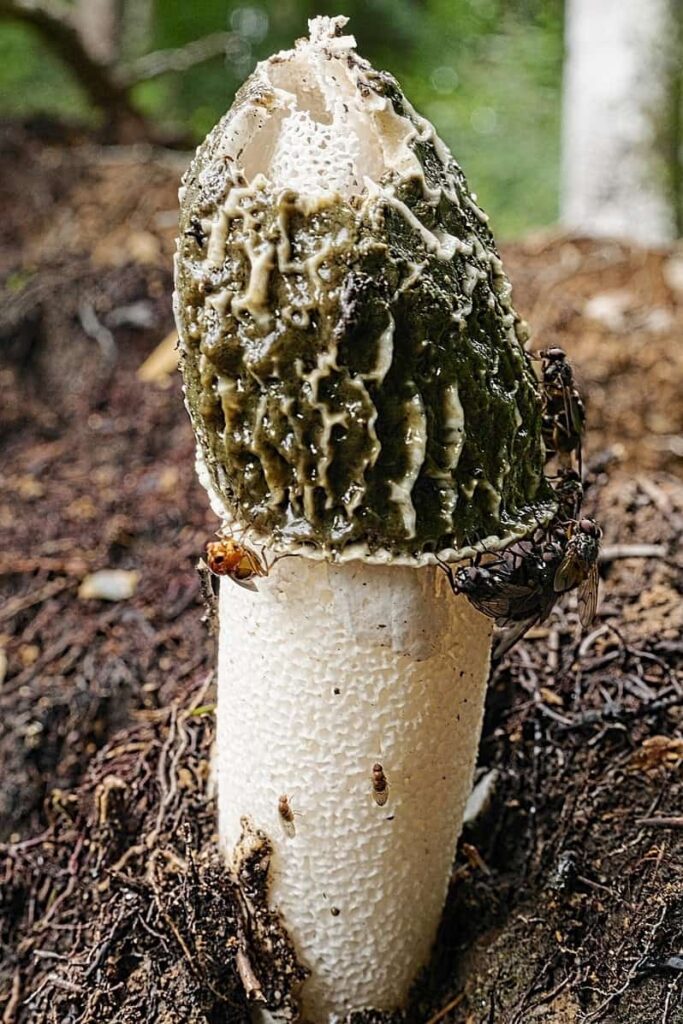
| Scientific Name | Phallus impudicus |
| Common Name | Common stinkhorn, witch’s egg |
| Distinct Characteristics | Phallic shapeOlive capFleshy white stalk |
The common stinkhorn is prevalent in the woody forests and mulched gardens of North America and Europe. It usually appears during the summer and autumn seasons.
This fungus thrives in deciduous trees with rotting wood.
The common stinkhorn is easily recognizable with its olive-green conical head covered by a spore-containing gleba. The odor it emits has been described to resemble carrion.
2. Bamboo mushrooms (Phallus indusiatus)
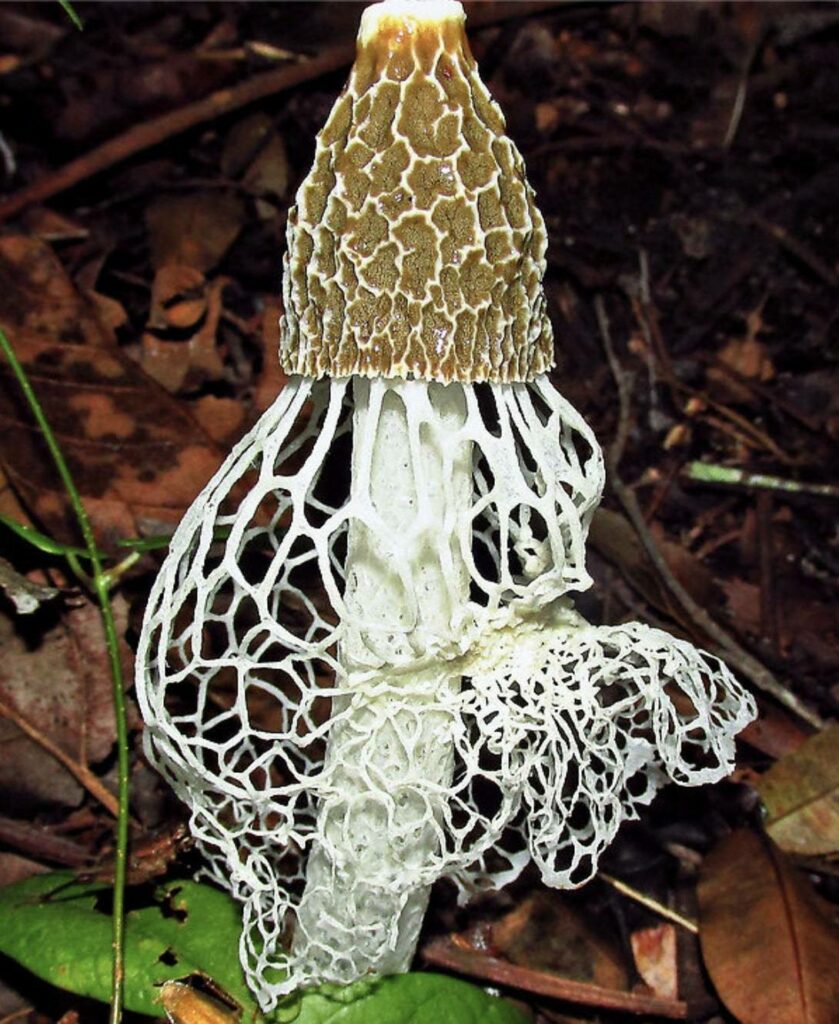
| Scientific Name | Phallus indusiatus |
| Common Name | Bamboo mushrooms, bamboo pith, long net stinkhorn, crinoline stinkhorn, veiled lady |
| Distinct Characteristics | Greenish brown capLacy skirt flowing below the capWhite stalk |
Bamboo mushrooms are common in the woodlands and gardens of southern Asia, Australia, Americas, and Africa.
The Phallus indusiatus is known for having a lacy skirt called indusium that flows from beneath the cap to the ground.
It is an edible mushroom commonly used in Chinese cuisine in making stir-fries and chicken soups.
3. Dog stinkhorn (Mutinus caninus)
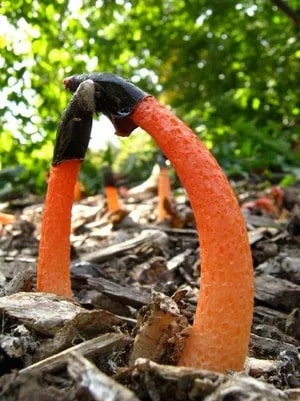
| Scientific Name | Mutinus caninus |
| Common Name | Dog stinkhorn |
| Distinct Characteristics | White volvaPolystyrene textured yellow-orange stemOlive cone-shaped cap |
The dog stinkhorn is a tiny phallus-shaped fungus commonly found in Asia, Europe, and eastern North America. It appears in clusters or fairy rings of leaf litter and rotting stumps.
The dog stinkhorn can easily be identified through its yellow-orange stem and cone-shaped olive cap.
The Mutinus caninus has a less foul smell than the common stinkhorn.
This mushroom fungus is edible at the egg stage. It is usually peeled and fried when used as a tasty dish.
4. Starfish fungus (Aseroe rubra)
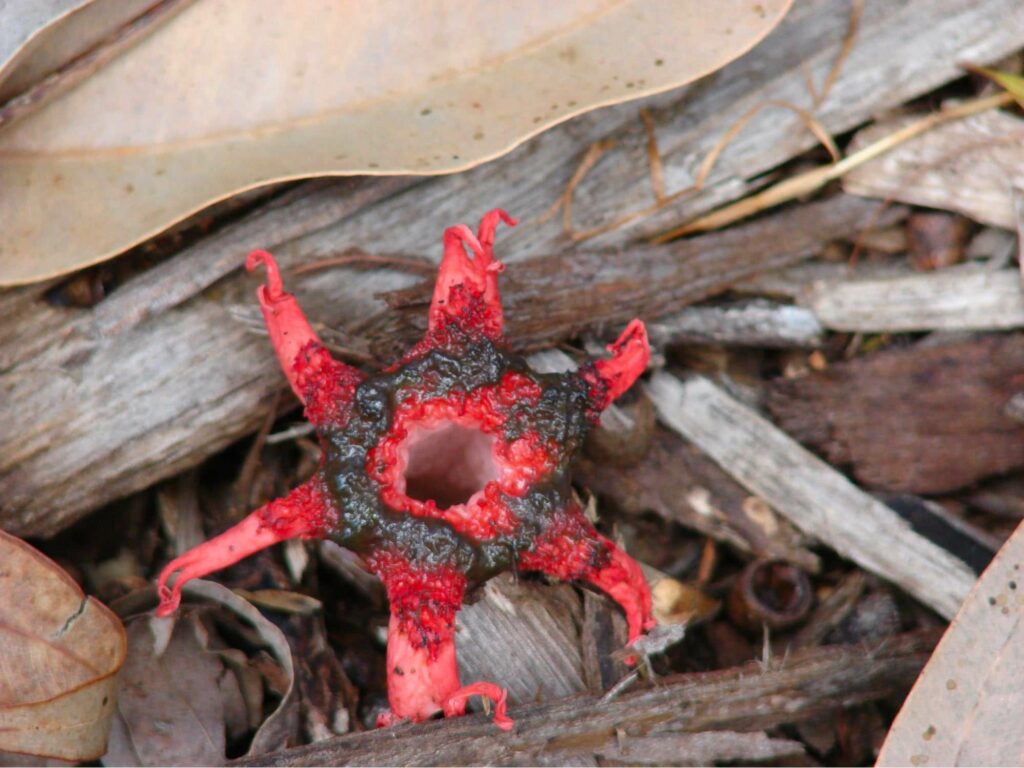
| Scientific Name | Aseroe rubra |
| Common Name | Anemone stinkhorn, sea anemone fungus and starfish fungus |
| Distinct Characteristics | Shaped like a pinkish red sea anemonePink fleshy stemWhite volva |
The Aseroe rubra is a stinkhorn mushroom common in Britain and Australia.
It has a pale brown egg that measures 3 centimeters in diameter that usually grows on rotting wood debris and leaf litter.
Upon maturity, the starfish fungus has six to ten bifurcated arms emerging from the volva of the egg. These arms are coated with an olive gleba containing its spores.
5. Basket stinkhorn (Clathrus ruber)
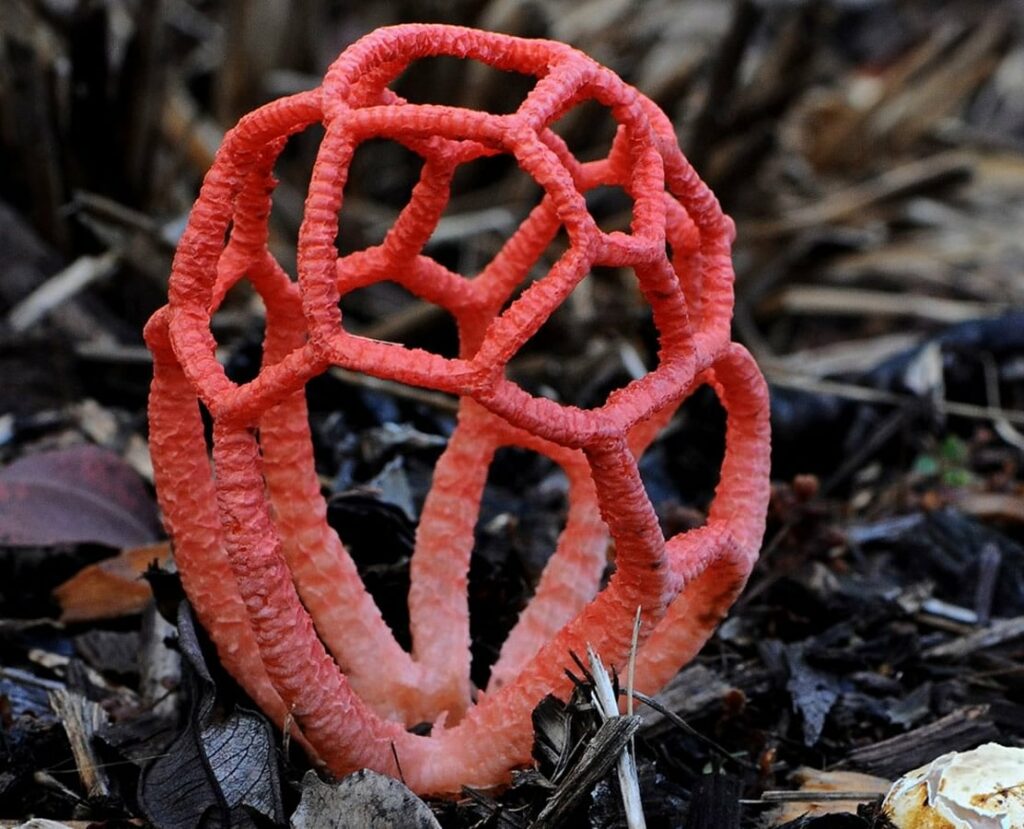
| Scientific Name | Clathrus ruber |
| Common Name | Latticed stinkhorn, the basket stinkhorn, the red cage |
| Distinct Characteristics | Reddish-pink hollow sphere with latticed branches |
The basket stinkhorn is native to southern and central Europe. It is commonly found in woody debris and mulch beds.
The Clathrus ruber has a recognizable reddish-pink oval sphere with interlaced branches.
As a saprophytic mushroom, it decomposes plant and wood matter, which serves as food for other plants and nutrients for the soil.
6. Octopus stinkhorn (Clathrus archeri)
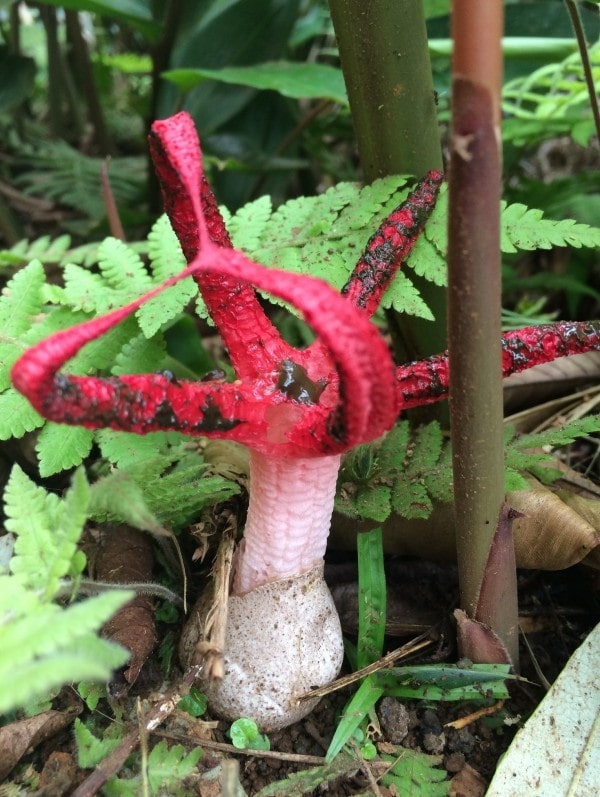
| Scientific Name | Clathrus archeri |
| Common Name | Octopus stinkhorn, devil’s fingers |
| Distinct Characteristics | Red orange starfish-shaped fungus4 to 6 arms |
The octopus stinkhorn thrives in decaying vegetation such as leaf litters, mulches, grasslands, and woodlands. It is endemic to Australia, New Zealand, and southern Africa.
From its volva emerges a red-orange starfish-like fungus with 4 to 6 arms. Each arm stretches up to 10 centimeters and is coated in gleba.
Its odor has been likened to the scent of rotting flesh.
7. Stinky squid (Pseudocolus fusiformis)
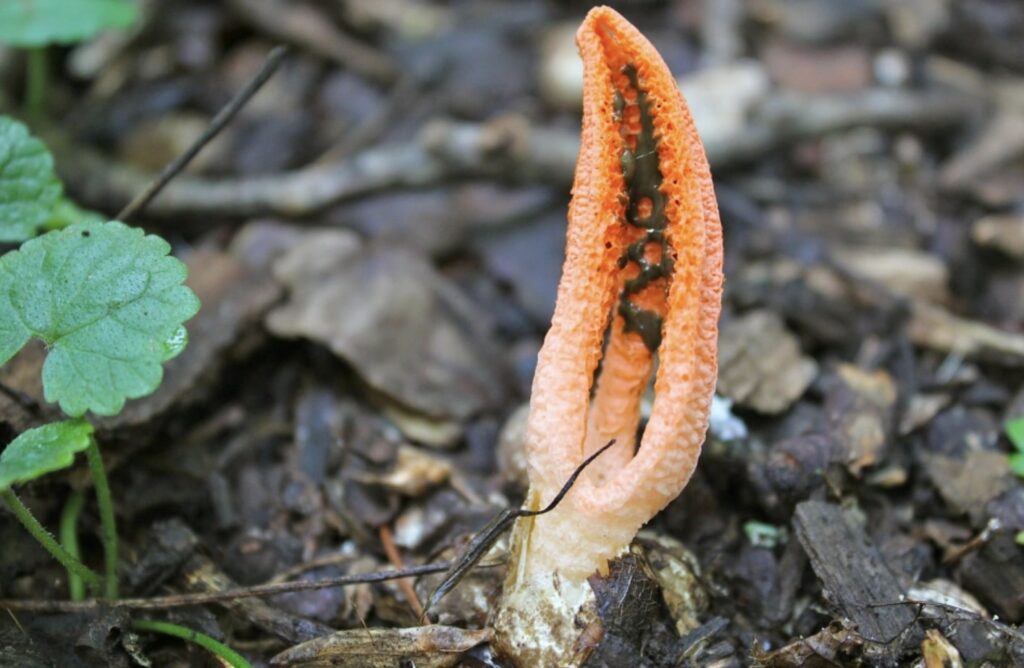
| Scientific Name | Pseudocolus fusiformis |
| Common Name | Stinky squid |
| Distinct Characteristics | 3 to 4 pinkish-red arms joined at the top |
The Pseudocolus fusiformis can be found in coniferous and mixed forests of Australia, Japan, Java, Philippines, and the United States.
The stinky squid is identified through its 3 to 4 arms that are rejoined at the tip. It is covered by a dark green gleba inside its arms.
The stink squid grows up to 5 inches in height and is usually found solitary in gardens.
What causes stinkhorn fungus?
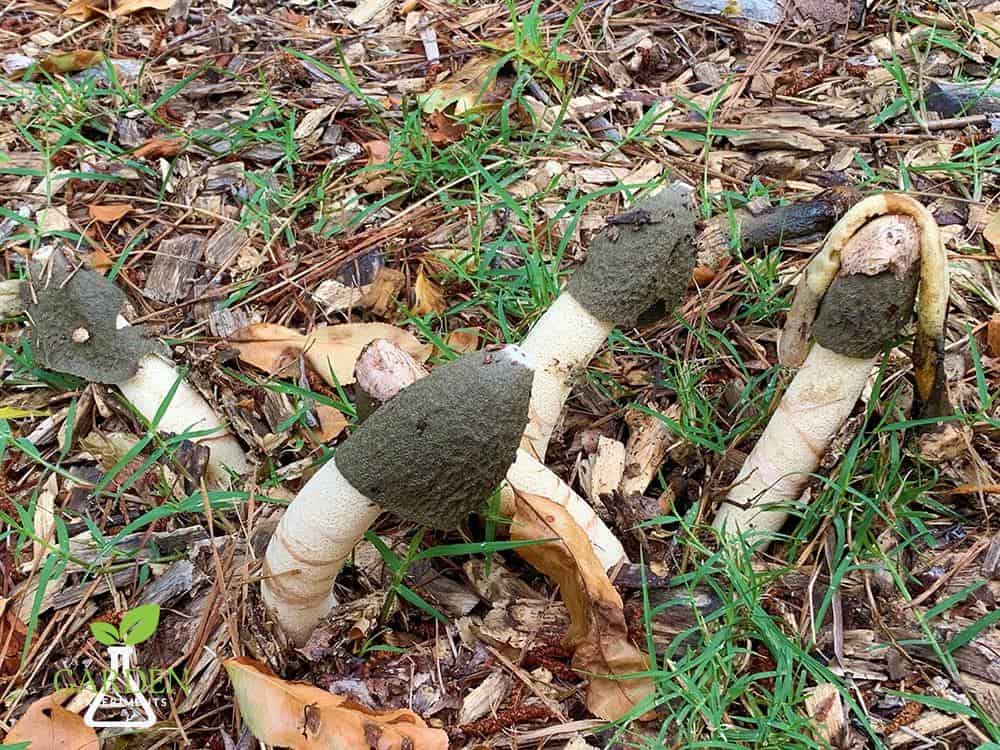
The growth of stinkhorn fungus is caused by mulches of rotting tree barks and moist areas. That is why they are commonly found in tropical and temperate regions.
They come out of the bulbous base when the weather is wet and humid. As the stinkhorn fungus rises from the ground, it exposes its mushroom cap called gleba, which contains its spores and emits a foul smell.
The unpleasant yet powerful smell attracts insects that carry and spread their spores to soils and mulches, repeating its reproduction cycle.
How do you get rid of stinkhorn mushrooms?
Stinkhorn mushrooms are ephemeral as they have a short lifespan and naturally disappear.
But if its smell becomes too unbearable or a safety hazard, here are ways to get rid stinkhorn mushrooms:
1. Manually remove them from your garden.
It is best to remove them after rainy periods and follow these steps:
- Wear gloves to protect your hand from the persistent smell of the stinkhorn mushroom.
- Dig beneath the ground until you reach the base of the mushroom.
- Pull the mushroom and its base out of the ground. Make sure to include the egg-like base so it will not reproduce.
- Place the stinkhorn mushroom in a plastic bag and throw it in the garbage can.
2. Replace the mulches.
Stinkhorn mushrooms are commonly found on mulches of rotting hardwood and softwood barks.
To control and stop its spread, you can replace your old hardwood and softwood mulches with pine needles or straws.
Unfortunately, no fungicide or other chemical treatment can completely eradicate stinkhorn mushrooms, so the best way is to control their presence through the two methods above.
Frequently Asked Questions
Stinkhorn mushrooms are not yet poisonous during their egg stage. This is when it does not emit an unpleasant smell.
However, they can easily be confused with other toxic mushrooms in the egg stage. So make sure you are 100% certain of what type of mushroom is before consuming it.
An apparent sign of toxicity is a mushroom’s repulsive appearance and odor. Once you encounter it, be extra careful in identifying it before ingesting them.
You can certainly touch a stinkhorn mushroom, although its unpleasant smell might stay a bit longer in your hands. Overall, these stinkhorns are not harmful to plants or people.
You can eat stinkhorn mushrooms at the egg stage. Mushroom foragers describe it as crunchy and crispy with a radish-like taste.
The stinkhorn volva’s inner layer can be cut in the middle and eaten raw.
Stinkhorn mushrooms are actually good for plants. As they grow on rotting wood, they break it down to organic matter to feed other plants and improve soil fertility.




